Barons
Otto von Bismarck
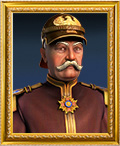
A master statesman, the 'Iron Chancellor' Otto von Bismarck was a key figure in the establishment of the German Empire in 1871. After guiding his country through war with Denmark, Austria and France, Bismarck ushered in a new era of peace and prosperity characterised by a surge in railroad construction, which unified the empire in a political as well as transportational sense. Despite his achievements, Bismarck lost favour with both his emperor and much of the country he helped to form, and was forced to resign in 1890.
Sidney Bruce

Originally a dynamic duo, Sidney and Bruce were famous for bringing joy to millions by creating some of the world's most beloved game series. However, their successes only fuelled their ambition… Soon they began experimenting with time travel in an attempt to cure 'One More Turn' Syndrome — a state of timelessness experienced by those who really, really enjoy strategy gaming. Both stepped into their prototype time machine, but only one man, embodying the best of two brilliant minds, emerged into the golden age of rail!
Isambard K. Brunel
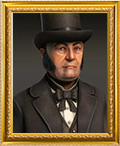
Isambard Kingdom Brunel began work as an engineer beside his father Marc, designer of the Thames Tunnel, before striking out on his own. Designer of various bridges and steamships throughout his career, such as the massive Great Eastern steamer, Brunel even served as chief engineer of the Great Western Railway. He helped build the line's distinct broad gauge rail system, which he believed to be superior to standard gauge rails in both comfort and capacity.
Jay Cooke
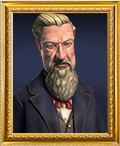
A financier first, Jay Cooke not only made his own millions but raised nearly two billion dollars for the Union during the Civil War, through clever advertising of his war bonds. After the war, Cooke began work on his Northern Pacific Railroad. Construction was plagued with setbacks and Cooke was forced to declare bankruptcy — the resulting nationwide depression became known as the Panic of 1873.
Charles de Gaulle
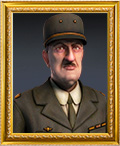
For Charles de Gaulle, speed was of the essence. A career soldier, he was one of the first to call for the mechanisation of the French forces before World War II. After the war, he was placed in charge of the French provisional government, but later resigned due to dissatisfaction with the country's new constitution. Yet, when his country needed him again, de Gaulle returned to the presidency and transformed France into a modern and independent nation. De Gaulle's 'blanchissage' — or 'redesign' — of Paris led to the creation of the city's underground rail system, the RER.
Jim Fisk
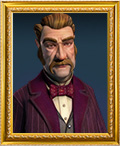
In an age of quiet, reserved businessmen, "Jubilee Jim" Fisk was a rebel upstart. Deciding schooling was not for him, Fisk explored various career paths, among them running off with the circus, before he found his way to Wall Street. Together with Daniel Drew and Jay Gould, Fisk tricked Cornelius Vanderbilt into spending exorbitant amounts of money to attempt a buyout of the Erie Railway, only to snatch it out from under Vanderbilt's nose at the last minute. Though his exuberant behaviour might have been the source of his success, it was also his undoing — he was shot to death by his business partner, Edward S. Stokes, during a dispute over a young Broadway showgirl named Josie Mansfield.
Jay Gould
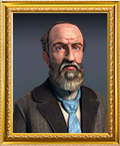
Daniel Drew once said of Jay Gould, his one-time partner, that "his touch is death". Known as one of the shrewdest of the robber barons, Gould made his name as a cutthroat speculator. As president of the Erie Railway, he gutted the company for profit, and was eventually forced to relinquish control amid public outrage at his manipulations. In his later years, Gould looked westward and bought heavily into the famous but poorly managed Union Pacific Railroad. What was expected to be another gut-and-run turned out to be a sincere interest in remedying Union Pacific's woes, with Gould modernising and expanding the previously forsaken railroad.
Jim Hill

A Canadian businessman known as 'The Empire Builder', Jim Hill's coal conglomerate gave him a vested interest in seeing North America covered by coast-to-coast railroads. Hill invested in and expanded the St. Paul & Pacific Railroad, populating its routes with settlers and industry. Hill had a voracious appetite for expansion, organising one of the most successful transcontinental railroads ever built and partnering with some of the most shrewd investors of the age, like J. Pierpont Morgan.
George Hudson

George Hudson, England's "Railway King," was the son of wealthy farmers, and began his career as a draper. He soon became a major investor and proponent of the North Midland Railway, eventually becoming the director of the burgeoning rail system. Through equal parts acumen and machination, Hudson eventually came to control one third of the rail lines in Britain. As his success came under scrutiny and investigations into Hudson's finances arose, confidence in his businesses fell, leading the "King" into a dethroning bankruptcy.
Helmuth von Moltke
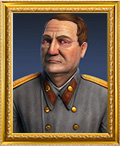
Military genius and lifelong railway enthusiast, Helmuth von Moltke the Elder (not to be confused with his nephew, ‘the Younger’), was the Prussian army's Chief of Staff for thirty years. Throughout a distinguished career in service of no fewer than three German emperors, he pioneered the application of rails for military mobilisation and logistics, becoming one of the first directors of the Hamburg-Berlin Railway. Enamoured with the speed and reliability of trains in times of war, Moltke the Elder established the Railways Department in his later career, an arm of the Great General Staff which oversaw the advancement and management of railways for military purposes.
J. Pierpont Morgan

J. Pierpont Morgan took after his wealthy financier father in becoming one of the most important investors in American history. As locomotion became a key force of the economy, Morgan became a board member on the famous New York Central, and a conduit between railroads and potential investors. From selling out-of-date rifles to the Union Army, to saving the United States from a depression, Morgan's skill as a businessman could not be denied — no matter how questionable his ethics.
Napoleon III

Emperor Napoleon III, born Charles Louis Napoleon Bonaparte, seized control of the French crown in a coup d'etat after refusing to step down at the end of his presidential term. Giving birth to the French Second Empire, new levels of prosperity and modernisation came at a heavy cost to the people's liberty. Part of this modernisation was a rapid expansion of the French rail system, which went from almost non-existent to nearly 11,000 miles of track in only thirty years.
Czar Nicholas II

Known for his obsessing over grand schemes while ignoring the day-to-day care of his subjects, Czar Nicholas II was Russia's final monarch. He brought about the creation of the famed Trans-Siberian Railroad, as well as an increase in Russian coal and iron production — thanks, in large part, to his shrewd Minister of Finance, Sergei Witte. However, due to his increasingly harsh reactions to the growing labor unrest in his country, and a less than keen understanding of his citizens, Nicholas was killed during the Bolshevik Revolution in 1918.
Baron Rothschild
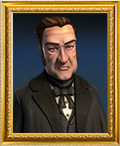
Member of the famous banking family, Baron James Mayer de Rothschild was one of France's most prominent financiers. After the installation of King Louis-Philippe, his loans shored up the finances of the new constitutional monarchy, and helped to ensure peace between France and Austria. Rothschild also helped fund many of the prosperity projects of Louis-Philippe's successor, Napoleon III, taking a key role in the expansion of the continental rail system.
George Stephenson

George Stephenson had a penchant for machinery from a young age, and would go on to become one of the first and finest locomotive designers of his era. Responsible for the design of Britain's first steam-powered rail system, the Stockton & Darlington Railway, Stephenson made a name for himself throughout Great Britain as the Father of Railways. Along with his son Robert, Stephenson's designs ushered in a new era in transportation the world round.
Cornelius Vanderbilt
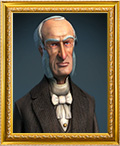
As a boy, Cornelius Vanderbilt began his transport career working on a ferry between Staten Island and Manhattan. His insatiable work ethic eventually turned that single boat into a fleet of transport ships, earning him the name "Commodore". Not until Vanderbilt was well into his sixties did he begin investing in the rails, but when he did he quickly became a force to be reckoned with. First purchasing the New York and Harlem Railroad, and later the New York Central Railroad, he merged them with other lines into one of the Northeast's largest rail systems. Despite a costly, failed attempt to acquire the Erie Railway, Vanderbilt still left behind an estate worth over $100 million.
Before purchasing please check the store page to confirm that your device is supported.



